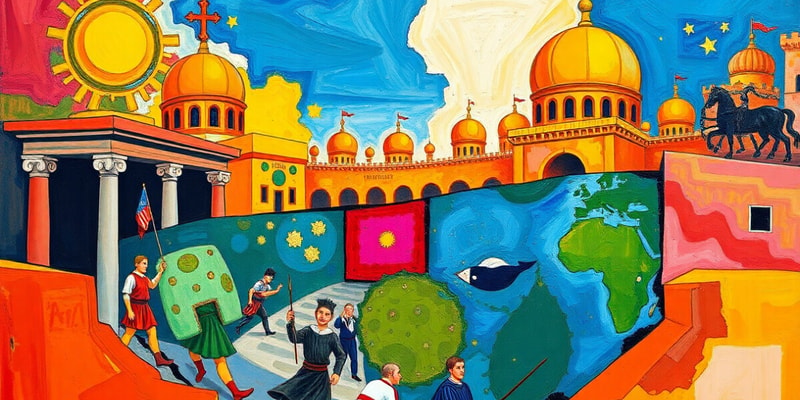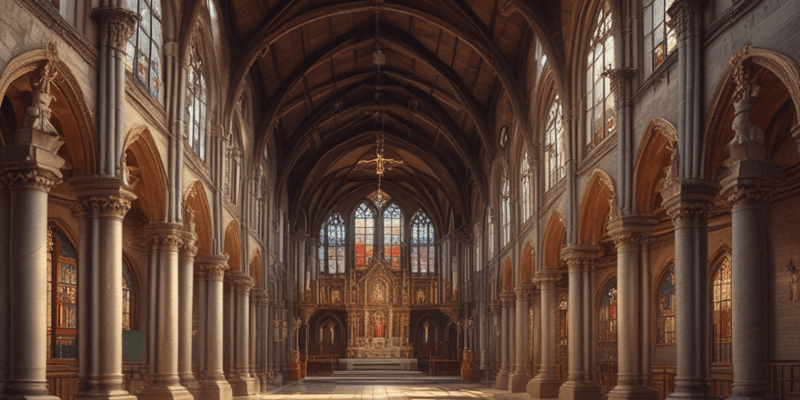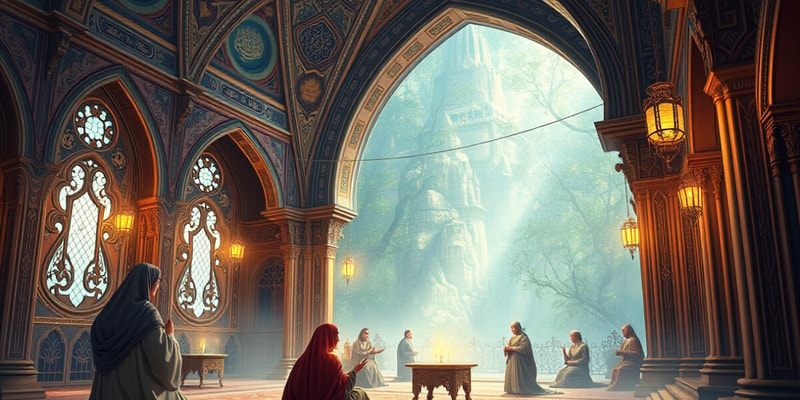Podcast Beta
Questions and Answers
Which of the following best describes the religious landscape of the Roman Empire?
The Colosseum was completed in 79 BCE.
False
What significant process facilitated the spread of Christianity throughout the Roman Empire?
Christianisation
The Colosseum could hold approximately __________ spectators.
Signup and view all the answers
Match the following groups to their corresponding regions within the fragmented Western Roman Empire:
Signup and view all the answers
Which region was not recaptured by the Byzantines in the 620s?
Signup and view all the answers
The unification of the Arab tribes was a significant factor for the expansion of Islam.
Signup and view all the answers
What year did the significant conquests of the Arab armies reach vast areas of the Eastern Roman and Sasanian Empires?
Signup and view all the answers
By the year 642, the Arab armies extended their conquests into the heartlands of central Asia and as far as __________.
Signup and view all the answers
Match the following locations with their historical significance during the Islamic expansion:
Signup and view all the answers
What was the primary source of income for many Roman households during the early fifth century?
Signup and view all the answers
In the late empire, the monetary system was primarily based on silver.
Signup and view all the answers
Who established Christianity as the official religion during Late Antiquity?
Signup and view all the answers
The income range for second-class households in Rome was between _____ to _____ pounds of gold.
Signup and view all the answers
Match the historical figures with their roles during Late Antiquity:
Signup and view all the answers
What element of the late Roman bureaucracy contributed to the problems in the government?
Signup and view all the answers
Civil rights were disregarded during the reign of the Roman emperors.
Signup and view all the answers
What was a major reaction of the Roman government to protests?
Signup and view all the answers
The late Roman monetary system shifted from silver to _____ due to the exhaustion of mining resources.
Signup and view all the answers
Which century did the significant rise of Islam occur that impacted Late Antiquity?
Signup and view all the answers
Study Notes
Religious and Political Transformations
- The Roman Empire was diverse in its religious practices, with polytheism being prevalent.
- Judaism was another prominent faith within the empire, but it displayed internal diversity.
- The spread of Christianity was a gradual process, driven by the church hierarchy.
- The Western Roman Empire fragmented into Germanic kingdoms, ushering in the medieval period.
- The Eastern Roman Empire prospered under Justinian, marked by economic growth and imperial ambitions.
The Colosseum
- The Colosseum, built in 79 CE, hosted gladiatorial contests and wild-animal displays.
- It had a capacity of 60,000 spectators.
Themes in World History - Chapter 54
- In the 7th century, Islamic expansion began in Arabia, leading to the conquest of vast territories within the Eastern Roman and Sasanian empires.
- The Byzantines, successors to the Roman Empire, regained control of eastern provinces like Egypt in the 620s.
- The conquests of Arab armies extended into central Asia and as far as Spain.
- The unification of Arab tribes within the Arabian peninsula contributed to the spread of Islam.
An Empire Across Three Continents
- The Colosseum was constructed in 79 CE during the Roman Empire.
- It's known as the Flavian Amphitheatre.
- The Colosseum’s design was revolutionary for its time.
Incomes of the Roman Aristocracy, Early Fifth Century
- Roman aristocracy lived in grand houses with amenities like hippodromes, temples, and baths.
- Many households had an annual income of 4,000 pounds of gold, with grain, wine, and other produce contributing an additional one-third of their income.
- Second-class households earned between 1,000 to 1,500 pounds of gold annually.
Late Antiquity
- Exhausted Spanish silver mines led to a shift in the Roman currency system, transitioning from silver to a gold-based system under Constantine.
- The late Roman bureaucracy was affluent, receiving salaries in gold and investing in land.
- Corruption was widespread, especially in the judiciary and military supply administration.
- The Roman state was authoritarian, often reacting to protests with violence.
- A powerful tradition of Roman law emerged, aiding as a check on even the most tyrannical emperors.
- The period of Late Antiquity (4th-7th centuries) witnessed significant cultural and economic transformations.
- Christianity became the official religion under Constantine.
- The rise of Islam in the 7th century further impacted the period.
Social Hierarchies
- Roman society was divided into distinct social groups.
- The elite were senators (patres) and the equestrian class.
- The lower classes included plebs sordida (the unkempt lower class), slaves, and various laborers.
- The middle class comprised individuals employed in imperial service, bureaucracy, and the army, as well as merchants and farmers.
- The aristocracy expanded under Constantine, with many members originating from Africa or the East.
- Military elites, often from non-aristocratic backgrounds, held considerable influence in the late Roman Empire.
The Structure of the Roman State in the Fourth Century CE
- The Roman state underwent structural changes under Emperor Diocletian, including increased autonomy for military commanders and a separation of civilian and military functions.
- Emperor Constantine introduced innovative changes, establishing a new gold coin (the solidus) and a second capital in Constantinople.
- The fourth century saw economic prosperity, marked by population growth, investment in infrastructure, and a revival of trade with the East.
- Taxes in Egypt reached over 2.5 million solidi per year during Justinian's reign.
Religious Culture
- The classical world practiced polytheistic religions, with a multitude of cults dedicated to Roman, Greek, and Eastern deities.
- Temples, shrines, and sanctuaries were common throughout the empire.
Studying That Suits You
Use AI to generate personalized quizzes and flashcards to suit your learning preferences.
Description
Explore the significant religious and political transformations during the decline of the Roman Empire and the rise of Islam. This quiz covers key events, structures like the Colosseum, and the transition from polytheism to monotheistic faiths. Test your understanding of how these changes shaped world history.




